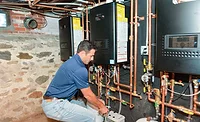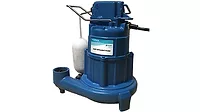Tech Savvy: Residential Cast-Iron Boilers And Low-Water Cutoffs
Low-water cutoff devices are one of the newest issues regarding residential boiler installations. Several states are now requiring a low-water cutoff device on all residential hot water heating systems.
Up to this point, these devices have commonly been used on light commercial and commercial hot water heating systems to meet the required "CSD-1" code requirements of the individual states. The commercial devices, however, are of the manual reset type and are generally provided as part of the heating equipment control package.
This is not the case with residential boilers. According to the "1996 International Mechanical Code" Section 1007: "All
steam and hot water boilers shall be protected with a low-water cutoff control." The code further states: "The low-water cutoff
shall automatically stop the combustion operation of the equipment when the boiler drops below the safest water level as
established by the manufacturer."
When to use low-water cutoff devices?
If you happen to reside in one of the states that have adopted and are enforcing this code, then you are probably already using these devices. The code prior to 1996 called for a low-water cutoff device to be installed in all hot water heating systems with radiation at or below the water level of the boiler. These states are now requiring the low-water cutoff devices on all hot water boiler installations.These devices will not be provided with the residential hot water boiler in most cases. You will have to provide for the cost of this device and its installation in your estimate.
Some manufacturer's models may come equipped with a low water pressure cutoff switch to interrupt the operation of the boiler in case of a sudden drop in system pressure. But local code always prevails, and a low-water cutoff device may also have to be installed.
Keep in mind that an activated low-water cutoff device has interrupted the combustion process, but not the flow of feed water. Upon discussing this with various mechanical inspectors, the consensus is that the service valve before the pressure reducing/feed water device should be closed upon initial static fill and purging.
Many manufacturers of pressure reducing/feed valves advise shutting them off in their installation instructions. This will
prevent additional water from entering the system to replenish water lost from a leak or break and, thus, will prevent further
property damage from excessive water.
Where to install low-water cutoff devices?
The tappings provided on hot water boilers are usually dedicated to the various control devices and gauges that the boilers are equipped with. There is generally not a tapping provided for a low-water cutoff device unless of course the section assembly can be configured as a steam boiler.Speaking as a manufacturer, we would desire that the low-water cutoff device be installed in the system supply piping instead of in the boiler in a hot water application. In the case of a section assembly that can be used as a steam boiler, the tapping for a probe-type, low-water boiler cutoff is there to ensure the water level remains above the lowest permissible water level for use only as it is configured as a steam boiler.
Hot water boilers are controlled by a high-limit aquastat that is usually installed at the upper portion of the boiler near the supply outlet. It is important to always have this device immersed in water in order to properly control the boiler's high-limit temperature. As a result, it is important to install a low-water cutoff device on the system supply piping to sense a low water condition before it reaches the boiler itself. This would involve installing the probe-type low-water cutoff in a tee just above the boiler with no service valve between the tee and the boiler supply outlet.
In the case of a few newer boilers that may come equipped with a low-water cutoff installed, the probe for the low-water
cutoff device is mounted in the highest point or dome of the boiler. This puts it above the immersion bulb for the high-limit
aquastat.
What type of low-water cutoff device?
Our technical services group frequently gets asked what type and voltage should the low-water cutoffs be. The device should always be an electronic probe-type. There are two types of these based on voltage of controls that they are governing. We would always advise installing the 120-volt instead of the 24-volt model. It is much simpler to always wire the low-water cutoff device so that it interrupts the line voltage feed to the boiler. This will eliminate the necessity to cut into the 24-volt wiring harnesses factory supplied on most gas-fired heating boilers. Altering these harnesses may affect boiler certification.On a gas boiler that is vented into a chimney, it is simple to determine which low-voltage wire to cut into to make this device function properly. This would generally be the blocked vent switch or flame rollout switch wire.
But on a fan-assisted boiler, this choice may not be so simple. It is much easier to interrupt the line voltage through the boiler service switch than it is to try to determine which low-voltage wire to cut into. This will protect the integrity of the factory wiring harness and guard against the possibility of blown transformers and other boiler components.
Abiding by these rules of thumb will provide the protection that the various code agencies are trying to achieve. The need for these devices is real, and in years to come, more and more states will be requiring these installations.
Looking for a reprint of this article?
From high-res PDFs to custom plaques, order your copy today!






